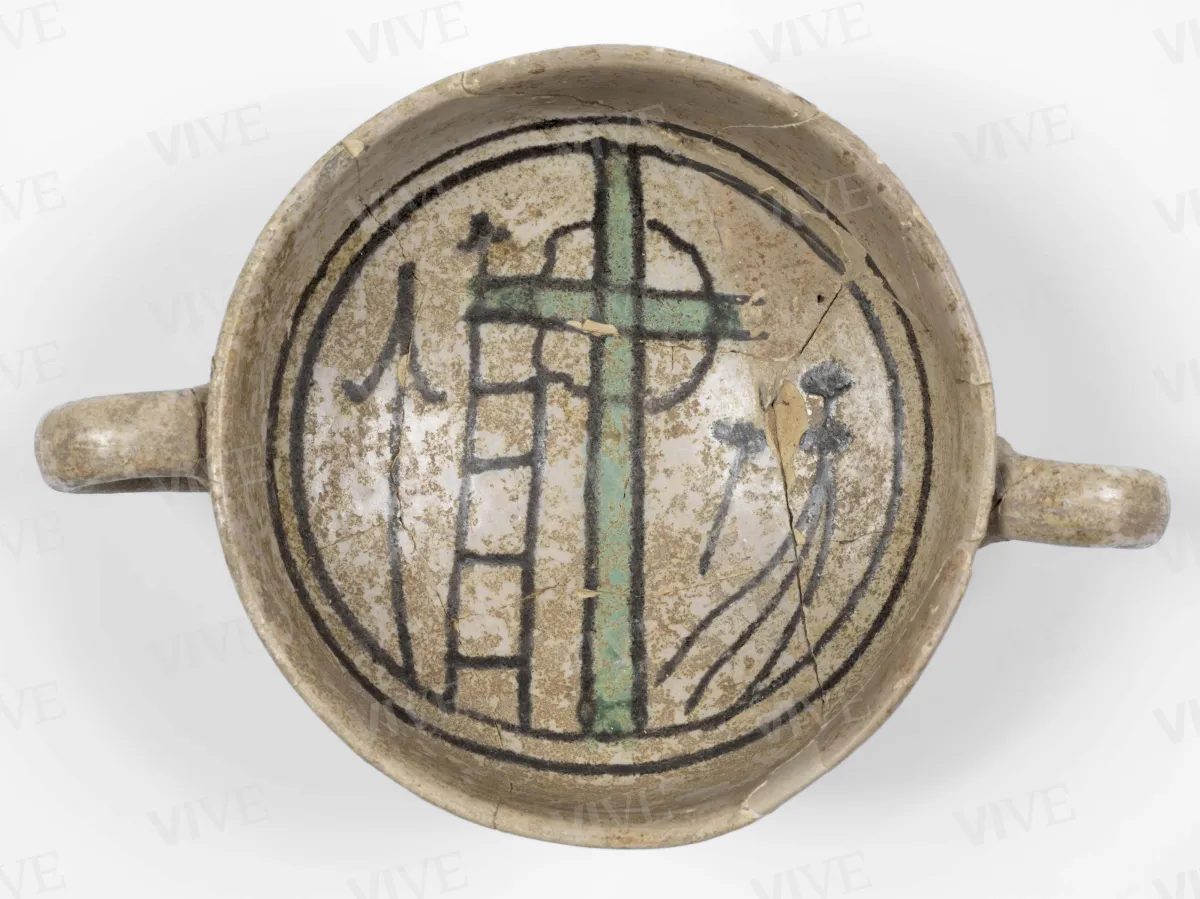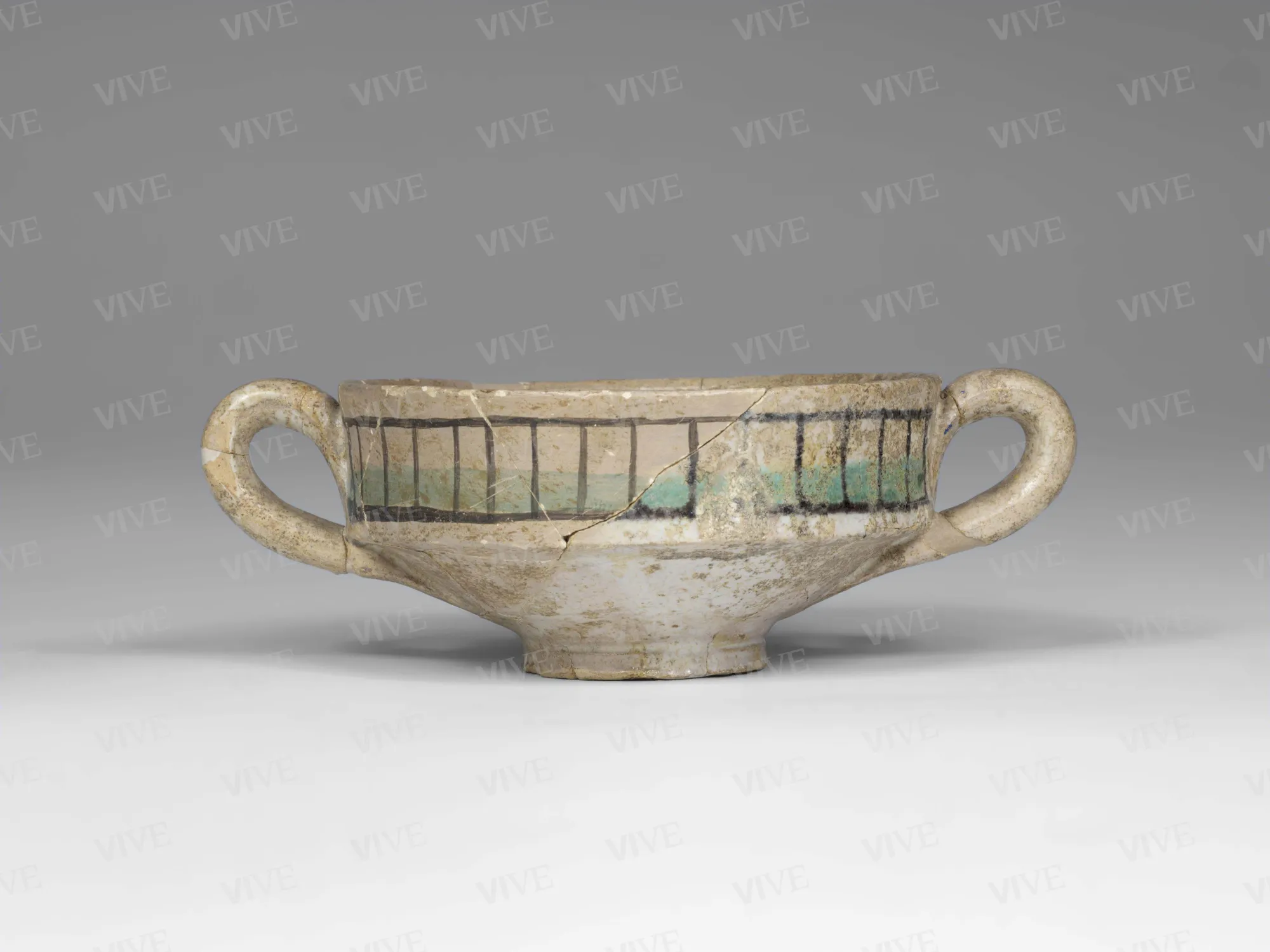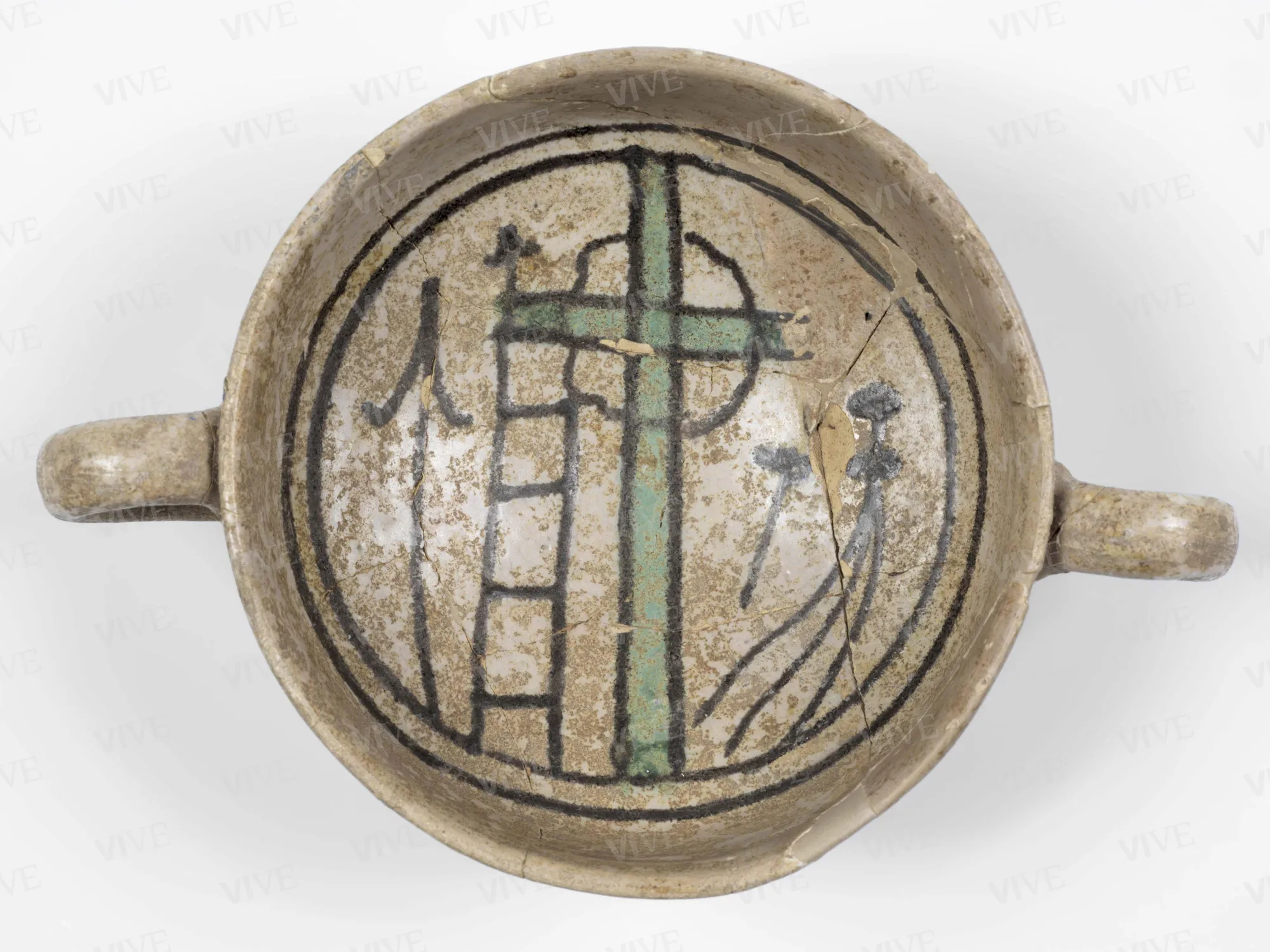Small hull-shaped bowl with symbols of the Passion
Orvieto milieu Low Middle Ages
Hull-shaped, two-handle Proto-majolica bowl with low body and tall foot, small, flat bottom, glazed internally and externally. In the center of the bowl, between two brown parallel lines designed to carefully define the space, are symbols from Christ's Passion: spear, ladder, nails, cross, crown of thorns, sponge, and scourges.
Hull-shaped, two-handle Proto-majolica bowl with low body and tall foot, small, flat bottom, glazed internally and externally. In the center of the bowl, between two brown parallel lines designed to carefully define the space, are symbols from Christ's Passion: spear, ladder, nails, cross, crown of thorns, sponge, and scourges.
Details of work
Catalog entry
Hull-shaped, two-handle Proto-majolica bowl with low body and tall foot, small, flat bottom, glazed internally and externally. In the center of the bowl, between two brown parallel lines designed to carefully define the space, are symbols from Christ's Passion: a spear, a ladder, nails, a cross, a crown of thorns, a sponge, and scourges. The find belongs to the so-called Proto-majolica phase. This term, taken from the designations traditionally used to define the periods of ancient Attic pottery, adopted by Gaetano Ballardini when he systematically classified Italian majolica, is used to chronologically define a type of glazed ceramic tableware produced from the mid-thirteenth century in central and northern Italy and whose basic characteristic is the presence of a stanniferous vitrified glaze over the container’s main surface, which is also embellished with pictorial decorations in copper green and manganese brown, while secondary surfaces are simply covered with a plumbiferous glaze. Proto-majolica forms are divided into open and closed types and are characterized by numerous variants and subvariants often produced in specific areas, such as the pelican mug typical of the Umbria-Latium area. Since the class occupies a rather broad chronological range, it is still problematic to date in order to establish a satisfactory overview of its evolution, but in central Italy the area occupied by this new class—which in terms of technique and final product was aimed at replacing previous tableware such as green glazed ceramics, underglazed painted ceramics, and Latium ceramics—would seem to be the city of Pisa. Generally speaking, it is possible to observe an “early phase” (1200–1250), relating exclusively to the production of Attic Majolica basins for architectural decorations; a “developed phase,” which can be dated to 1250–1350 when Attic Majolica, produced as tableware ceramics, is found in significant numbers in most archaeological sites; there is then a third, “late phase,” which goes from 1350 to the first half of the fifteenth century, during which, both morphologically and decoratively, we can see a series of internal elaborations that in some cases evolve into subsequent Renaissance forms. This large class contains distinct productions on an almost regional basis. Umbrian production—which this particular artifact belongs to—is usually associated with northern Lazio production, which in fact would seem to be strongly influenced by the former.
The decoration on the piece analyzed appears to be rather frequent in the northern Latium area in two-handle hull-shaped Proto-majolica bowls, but in this case characterized by small variations regarding the graphic rendering or the number of objects represented. In terms of graphic rendering, for example, it can be observed that the crown of thorns, still placed at the intersection of the arms of the cross, is rendered by means of a circular element crossed by transversal strokes or as a simple circular element with undulating contours; in the first case we have a more realistic rendering of all the other objects, while in the second, to which the find in question corresponds, the crown is associated with more stylized tools. Another interesting feature concerns the number of objects presented, which always nonetheless contain the following main symbols: a painted cross in the center of the composition, a crown of thorns, and the nails at the end of the horizontal arms. These may or may not be surrounded by other elements such as a scourging pillar, a ladder, a hammer, and a rod with sponge (which tend to appear more frequently), or a scourge, tongs, spear, and pot (which are rather rarer). The motif first appeared in Orvieto, where it is dated to the thirteenth–fourteenth centuries and then migrated south to Viterbo, Bolsena, Celleno, Tarquinia, and Cerveteri, where it appears around the mid-fourteenth century. Finally, there is an interesting Roman reinterpretation of the motif where the small hull-shaped, two-handle bowls created later and datable to the fourteenth and fifteenth centuries are decorated in one example with symbols associated with a praying saint and in another in the use of a single cross with highly stylized nails, a crown of thorns, and Golgotha. These small hull-shaped, two-handle bowls were mainly used for drinking but could also contain dipping sauces for raw vegetables and flatbreads, cooked fruit, or sweets. Similar shapes with slight morphological variations are found up to the end of the fourteenth century, when more advanced fairing made it easier to hold the container with the hands. The handles thus became superfluous, and were eliminated.
Beatrice Brancazi
Entry published on 12 February 2025
State of conservation
Mediocre. The find was subjected to two different restorations aimed at reconstructing and providing missing parts.
Restorations and analyses
The bowl is characterized by numerous missing sections that were replaced during two different restorations. The first restoration, probably datable to 1994, is more imitative in style, while the second, probably datable to 1998, is much more obvious.
Provenance
The artifact belongs to the collection of Giulio Del Pelo Pardi. In 1950, Del Pelo Pardi donated it, along with a typewritten catalog drafted by Pericle Perali, to the Museo di Palazzo Venezia, where it was almost immediately lost; in the 1990s, during a survey undertaken to retrieve and review the materials in the museum's depository, a collection was recovered and assumed to be the Del Pelo Pardi collection.
Exhibition history
Orvieto, Museo della Tradizione Ceramica, Palazzo Simoncelli, Oltre il frammento, December 18 1999–January 23 2000;
Faenza, Museo Internazionale delle Ceramiche, Oltre il frammento, May 20–September 30 2000;
Rome, Museo Nazionale di Palazzo Venezia, Oltre il frammento, October 25 2001–January 31 2002.
References
Mazza Guido, La ceramica medioevale di Viterbo e dell’Alto Lazio, Viterbo 1983, p. 80, fig. 99;
Sconci Maria Selene, Oltre il frammento: forme e decori della maiolica medievale orvietana. Il recupero della collezione Del Pelo-Pardi, Roma 2000, p. 156, fig. 115. p. 157, fig. 116, p. 155, fig. 114;
Tamburini Pietro, Un museo e il suo territorio. Il museo territoriale del lago di Bolsena. 2. Dal periodo romano all’era moderna, Bolsena 2001, p. 93, fig. 103a;
Casocavallo Beatrice, Le ceramiche rivestite bassomedievali, in Quaranta Paola, Casocavallo Beatrice (a cura di), La tavola imbandita. Ceramiche ceretane tra medioevo e rinascimento, catalogo della mostra (Tarquinia, Palazzo Comunale, Sala del Monte di Pietà, 8-30 novembre 2013), Acquapendente, 2013, p. 21, fig. 15;
Brancazi Beatrice, Miele Flora, Contenitori e simboli: i motivi religiosi delle ceramiche rivestite alto laziali, in «NUME», IV Ciclo di Studi medievali, 2018, pp. 357-359
Piermartini, in Luzi Romualdo, Romagnoli Giuseppe (a cura di), Le maioliche medievali dal butto di Celleno Vecchio, catalogo della mostra (Viterbo, Museo della Ceramica della Tuscia, 18 maggio-14 luglio 2019), Viterbo 2019 p. 47, fig. 15;
Brancazi Beatrice, Nascoste in piena vista. I molteplici legami tra la scrittura e la ceramica bassomedievale, in Campus Alessandro, Marchesini Simona, Poccetti Paolo (a cura di) Scritture nascoste, scritture invisibili. Quando il medium non fa “passare” il messaggio. Miscellanea internazionale multidisciplinare, Verona 2020.














